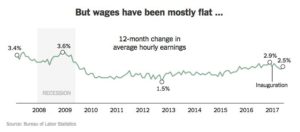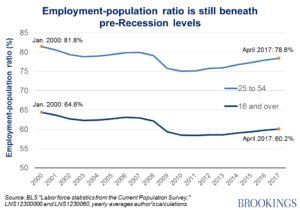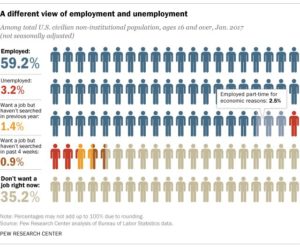It’s great to see that some tech companies are creating lots of new jobs. Long lines of people showed up and waited hours to apply when Amazon announced thousands of warehouse jobs. Business Insider’s Pedro Nicolaci da Costa notes that these throngs of job-seekers might surprise economists who see unemployment and underemployment as minor issues, given the current low official unemployment numbers.
However, a few charts complicate the seemingly rosy labor market picture. Above all, data indicates that the U.S. economy still has not fully recovered from the Great Recession. Wage growth has remained mostly flat since the Great Recession, and the numbers have only gone down since the inauguration of the new president in January. See this chart based on Bureau of Labor Statistics Data:

The Brookings Institution has found that the employment-to-population ratio is still below pre-Great Recession levels.

The Pew Research Center finds that since the Great Recession, a lot of people who want full-time jobs have been underemployed and unable to find non-part-time work.

Indeed, FiveThirtyEight blog found that the labor statistics look very different when you factor in this “hidden unemployment.”

The true employment rate for American adults age 16 and over is around 59%, according to the Pew Research Center.

It’s important to bear in mind that the majority of adults who are choosing not to work are doing so for sound reasons – they are stay-at-home moms, they are retired, they are disabled, or they are in college. Nevertheless, there is also a significant number of unemployed people who are not reflected in the official statistics because they have given up looking for work entirely and have dropped out of the labor market. Some of these individuals may be able-bodied and of sound mind, but have given up searching because they found that the current economy had no available jobs for them because they lack key skills or educational credentials.
In summary, the relatively low current unemployment numbers are encouraging, but there are concerns when one digs deeper. The quality and security of the jobs people currently hold is not reflected in the federal unemployment rate. Recent economic data shows a continuation of long-term patterns over the past 30 years indicating stagnant wages and widening income inequality. There are particularly poor economic conditions in small towns and rural areas, which have been hit particularly hard by “deaths of despair” and the skyrocketing opioid abuse epidemic documented in this graph by the New York Times:

The digital revolution has transformed our economy. It has disrupted industries, destroying jobs in some areas while creating them in others. The challenge of American society over the next quarter-century may be making sure that the digital revolution does not leave a large number of Americans without economic security and meaningful work.